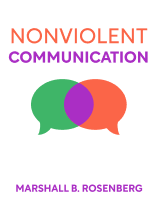

This article is an excerpt from the Shortform book guide to "Nonviolent Communication" by Marshall B. Rosenberg. Shortform has the world's best summaries and analyses of books you should be reading.
Like this article? Sign up for a free trial here .
What is the NVC empathy approach? How can you apply it in practice?
Nonviolent Communication provides a helpful framework for maintaining an empathic presence when people express themselves. In NVC, empathy requires focusing our full attention on the person and listening for the needs and feelings beneath their words.
Read about NVC, empathy, and communication.
The NVC Empathy Approach
Just like in expressive communication, when we listen to others in a nonviolent way, we focus on four things: observations, feelings, needs, and requests. Keep in mind that people are always expressing their feelings and needs when they communicate. Focus on listening for those feelings and needs, even when they’re expressed indirectly. For example, if someone says, “I hate my job,” they may really be trying to say, “I feel empty at work because I need recognition when I do a good job.”
Paraphrasing With Questions
When you focus on someone’s feelings and needs, be careful not to take your own interpretations of their words as fact. Instead, check in frequently to make sure you understand exactly what they’re saying. This prevents miscommunications from spiraling out of control and gives the other person a chance to make sure they’re being heard correctly (which ultimately saves everyone time and struggle). To do this, try paraphrasing the feelings and needs you hear in the form of a question.
To illustrate this, let’s look at an example based on a real-life married couple who attended a workshop on NVC empathy techniques. When the husband told his wife, “You never listen,” Rosenberg challenged her to listen for the feelings and needs behind the statement and respond with empathy. Here were her first few attempts:
- “Are you feeling unhappy with me?” This is an understandable question, but the words “with me” imply that her actions have caused her husband’s emotions. She automatically takes responsibility for his feelings, but remember, each of us is only responsible for our own emotions.
- “Are you feeling unhappy because you feel like I don’t understand you?” Here, she’s listening for the feelings as well as the needs behind them. But her language focuses on what her husband might be thinking about her rather than what he’s needing.
- “Are you feeling unhappy because you are needing to be heard?” This question reflects the husband’s feelings and his needs. It doesn’t matter if she’s guessed incorrectly about either of these because the question format gives her husband a chance to correct any misunderstanding.
You can also ask paraphrasing questions to clarify what someone is specifically observing (“Are you reacting to your boss skipping the meeting?”) or what they are requesting (“Are you wanting me to help you with this assignment?”).
Notice how these questions are different from questions like “How do you feel about that?” or “What do you need me to do?” These questions are well-intentioned but in practice can sound like analysis, which makes the listener feel like a problem you’re trying to solve. Instead, asking paraphrasing questions makes it clear that you’re really listening and empathizing with someone’s experience, even if you don’t interpret them correctly on the first try.
Things to Keep in Mind While Paraphrasing
Paraphrasing is especially important when someone is expressing powerful emotions because the person is particularly vulnerable. In that state, empathy is crucial because offering advice or criticism is likely to make someone feel unheard and unsafe. This applies to both what you say and how you say it. In an emotionally vulnerable situation, people are extremely sensitive to any hint of criticism, even through subtle vocal or body language cues.
Again, this may be especially difficult when someone’s feelings and needs are buried beneath insults and hateful words. Thankfully, over time, focusing on those feelings and needs makes it easier to see people as hurting human beings rather than irredeemable monsters, which ultimately takes away their power to hurt or dehumanize us.
When you paraphrase someone’s feelings and needs back to them, you act as a mirror that lets them take a deeper look at their own inner world than they may have otherwise. That kind of introspection can trigger new insights as buried feelings are unearthed. As the listener, this may sound like the speaker has switched topics entirely, but that doesn’t mean they no longer need you to listen empathically—in fact, those deeper wounds are the ones most in need of true empathy. For that reason, it’s important to continue listening without offering solutions for as long as it takes.
Once someone feels fully heard, there’s often a palpable sense of relief for both the speaker and the listener. You may notice a release of physical tension in your own body as the speaker winds down. When the process is fully worked through, the speaker will naturally stop talking as they sense their feelings and needs being fully understood.
It’s not always necessary or helpful to paraphrase someone’s feelings and needs verbally, especially if directly acknowledging the person’s emotions would cause embarrassment because of cultural norms. For example, Rosenberg once coached a man to use NVC empathy to transform his relationship with his father without ever paraphrasing out loud, because for a son to discuss his father’s emotions directly was socially taboo in traditional Chinese culture. In that case, it’s even more important to listen carefully for the feelings and needs being expressed, since you may not get the chance to check your understanding.
When NVC Empathy Techniques Hurt
There are times when true empathy is impossible, particularly when you’re starved for empathy yourself or worn out from empathizing with others. Likewise, if you’re feeling attacked or insulted by the other person, it’s natural to be pushed into a fight or flight response that blocks empathy. If the topic affects you personally, it may not be possible to maintain focus on the other person’s feelings and needs. Recognizing when you’re not able to give someone the kind of empathy that NVC requires is an important part of the process. In that case, you have a few options.
- First, you can offer yourself emotional first aid by focusing on your own feelings in the same nonviolent way. Being present with your own pain or exhaustion without judgment is a powerful form of empathy.
- Second, you can acknowledge that you’re simply not able to respond empathetically in that moment. Depending on the context, you can even directly ask for empathy in order to refill the “empathy tank.”
- When you’re truly worn down, it may not be possible to do this gently—it’s okay to release those difficult feelings by screaming as long as you do so nonviolently. In practice, “nonviolent screaming” just means expressing your own feelings and needs authentically, without holding back the intensity of your energy. The “nonviolent” part means that even if you raise your voice, you don’t blame, accuse, or insult anyone else. You simply call attention to your own desperate needs.
- Lastly, if neither of these approaches is useful, it may be necessary to physically step away from the conversation until everyone can cool down and refill their empathy tanks. This can help reboot an emotionally intense conversation and allow a fresh start when all parties are better able to empathize.
The Meaning of Silence
Sometimes, it can be more difficult to empathize with silence than with someone’s words. In the face of silence, our storytelling brains invent all sorts of worst-case scenarios for what someone else must be thinking and feeling. The NVC empathy approach challenges us to check those assumptions with the other person rather than assume we can read their mind.
For example, if you share something deeply emotional with someone who turns away with a disgusted look on their face, you may automatically interpret those silent cues as a sign that you’ve overshared or that this person disapproves of you somehow. But if you check those assumptions with empathy—“I’m sensing that you feel disgusted and you’d like me to keep my feelings to myself”—you may discover that their silence had nothing to do with you and everything to do with their own emotions about an experience you reminded them of. If you sense disgust or rejection in someone’s silence, it can be difficult to empathize. But silence can convey other feelings, too. Maybe you’ve noticed a friend who looks visibly upset but doesn’t want to talk about what’s wrong. Or imagine a teacher pulling a depressed-looking student aside to ask if they’re okay and getting only a shrug in response. In these cases, use the NVC empathy approach to “listen” to what someone is expressing nonverbally and reflect it back to them. This may encourage them to open up, or it may not—either way, what’s important is your ability to stay present and continue giving them your focused attention rather than walking away because you can’t “fix” their emotions.

———End of Preview———
Like what you just read? Read the rest of the world's best book summary and analysis of Marshall B. Rosenberg's "Nonviolent Communication" at Shortform .
Here's what you'll find in our full Nonviolent Communication summary :
- How nonviolent communication lets you have more compassion for yourself
- Why nonviolent communication is the key to fostering authentic connections with others
- The 4 steps to expressing yourself with empathy towards others






